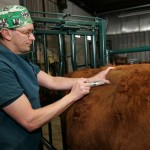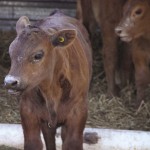Noticeable reactions to a vaccine injection are becoming more common, as more vaccines are now given subcutaneously and especially with vaccines using oil-based adjuvants. The adjuvants are designed to protect the vaccine and give a much higher immune response, but reactions in the form of lumps are an expected albeit undesirable result. As many of […] Read more

Vaccine reactions are normal — to a point
Proper injection practices help avoid infection, contamination

There is gain by reducing pain
Use of anti-inflammatory drugs is instrumental for the betterment of animal welfare
With the advent of the increasing consciousness in animal welfare, any products which can relieve pain, decrease inflammation and reduce fever are a welcome addition to the repertoire we as veterinarians have to treat clinical disease. They also may have a place in controlling post surgical pain or inflammation such as might occur with castration […] Read more

Strategies for reducing parasite resistance
We heard years ago about insect resistance developing with with fly tags. I believe the first ones on the market were called Bovaid. With no other competing products, after a few years researchers noticed resistance developing in pests the tags were supposed to repel. Soon other companies were making tags using different chemical families as active […] Read more
Branded beef pros and cons
Health and Welfare
With all the terms we are hearing in the beef industry — such as organic, natural, hormone-free, and sustainable — there is no doubt confusion even for producers trying to raise cattle to fit these programs. Most of these branded or niche programs are trying to differentiate themselves from traditional beef production practices. If as […] Read more

Be alert for common young calf problems
Every calving season, veterinarians are called on to examine calves with a multitude of problems. Some are herd management related but many are individual problems of no concern to the rest of the herd. Most cases fall into a few broad categories. Each category has a much different treatment regime. With calves, clinically we need […] Read more

Proper management can prevent scours
Animal health
Most calf scour documents focus on treatment of calf scours and methods involved to eliminate an outbreak. But with the proper management, preventative measures have proven to substantially reduce all scours. Nothing is foolproof, but if certain measures are followed incidence of the disease can be dramatically reduced. Certain management procedures should be avoided as […] Read more
Managing bullers in a feedyard
Fortunately, bullers are mostly a rare, sporadic occurrence in western Canadian feedlots and backgrounding operations. When dealing with these cases bear in mind the economic loss to the entire pen from frequent riding. Because the incidence is so sporadic no hard research has been done as to exact cause but several factors are suspected. Many facts have been gleaned from […] Read more
A poisonous weed that is rarely seen
With the wetter spring and summer, sightings of western water hemlock have increased. Prior to 2006 I personally had only seen one occurrence of this highly toxic plant in 25 years of practice. This year in a short time several findings with multiple plants in our practice area a great distance apart have been identified. […] Read more
A poisonous weed that is rarely seen
With the wetter spring and summer, sightings of western water hemlock have increased. Prior to 2006 I personally had only seen one occurrence of this highly toxic plant in 25 years of practice. This year in a short time several findings with multiple plants in our practice area a great distance apart have been identified. […] Read more
An ideal year to watch for lungworm infection
Every year in later summer and early fall we see a few outbreaks of lungworm in cattle on pasture. This is especially true if the year has been wet and the life cycle of the lungworm can be completed. This year could be the perfect storm in parts of Western Canada. The life cycle of […] Read more

